
The Elaeagnaceae are a plant family, the oleaster family, of the order Rosales comprising small trees and shrubs, native to temperate regions of the Northern Hemisphere, south into tropical Asia and Australia. The family has about 60 species in three genera.

Berberis aquifolium, the Oregon grape or holly-leaved barberry, is a North American species of flowering plant in the family Berberidaceae. It is an evergreen shrub growing up to 3 metres (10 ft) tall and 1.5 m (5 ft) wide, with pinnate leaves consisting of spiny leaflets, and dense clusters of yellow flowers in early spring, followed by dark bluish-black berries.

Berberis, commonly known as barberry, is a large genus of deciduous and evergreen shrubs from 1–5 m (3.3–16.4 ft) tall, found throughout temperate and subtropical regions of the world. Species diversity is greatest in South America and Asia; Europe, Africa and North America have native species as well. The best-known Berberis species is the European barberry, Berberis vulgaris, which is common in Europe, North Africa, the Middle East, and central Asia, and has been widely introduced in North America. Many of the species have spines on the shoots and all along the margins of the leaves.

Sanguinaria canadensis, bloodroot, is a perennial, herbaceous flowering plant native to eastern North America. It is the only species in the genus Sanguinaria, included in the poppy family Papaveraceae, and is most closely related to Eomecon of eastern Asia.

Cornus canadensis is a species of flowering plant in the dogwood family Cornaceae, native to eastern Asia and North America. Common names include Canadian dwarf cornel, Canadian bunchberry, quatre-temps, crackerberry, and creeping dogwood. It is a creeping, rhizomatous perennial growing to about 20 centimetres tall.
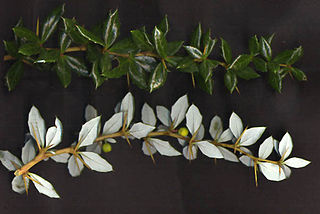
Berberis verruculosa, the warty barberry or warted barberry, is an evergreen shrub in the family Berberidaceae. It ranges in size from 1–2 m, and is native to western China. It gets its common name from its "warty" stems, that have rounded, more or less identical, raised spots.
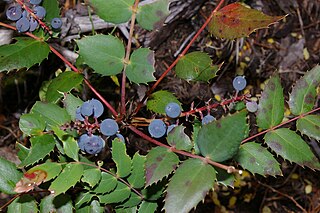
Berberis nervosa, commonly known as dwarf Oregon-grape, Cascade barberry, Cascade Oregon-grape, or dull Oregon-grape, is a North American flowering plant.

Berberis darwinii, Darwin's barberry, is a species of flowering plant in the family Berberidaceae, native to southern Chile and Argentina and naturalized elsewhere. Regional vernacular names include michay, calafate, and quelung. Growing to 3–4 m (9.8–13.1 ft) tall, it is an evergreen thorny shrub.
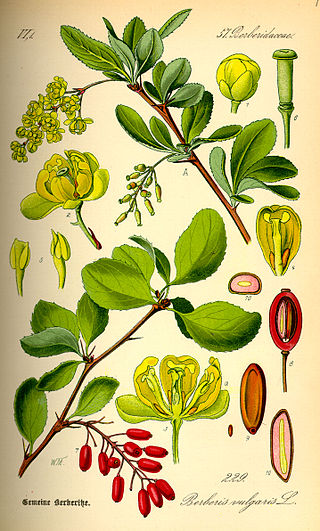
Berberis vulgaris, also known as common barberry, European barberry or simply barberry, is a shrub in the genus Berberis native to the Old World. It produces edible but sharply acidic berries, which people in many countries eat as a tart and refreshing fruit.

Berberis thunbergii, the Japanese barberry, Thunberg's barberry, or red barberry, is a species of flowering plant in the barberry family Berberidaceae, native to Japan and eastern Asia, though widely naturalized in China and North America, where it has become a problematic invasive in many places, leading to declines in species diversity, increased tick habitat, and soil changes. Growing to 1 m tall by 2.5 m broad, it is a small deciduous shrub with green leaves turning red in the autumn, brilliant red fruits in autumn and pale yellow flowers in spring.

Berberis repens commonly known as creeping mahonia, creeping grape holly, or creeping barberry, is a species of Berberis native to most of the western United States and two western provinces of Canada. It is low growing shrub that spreads by underground stems. As a species it is well adapted to fire and is a very common understory plant in western forests. An evergreen species, it provides food to deer and elk in winter and can make up a significant part of their diet. The berries are eaten by birds and small mammals, aiding it in spreading to recently disturbed areas. It has found use as a xeric ornamental plant and has escaped from cultivation in areas beyond its native range.
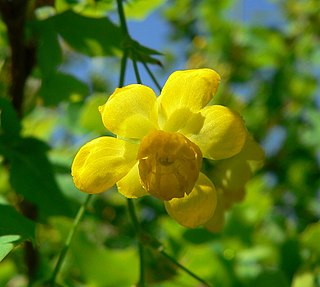
Berberis fremontii is a species of barberry known by the common name Frémont's mahonia.

Berberis aristata, also known as Indian barberry, Mara manjal (மரமஞ்சள்), chutro, sumba, or tree turmeric, is a shrub belonging to the family Berberidaceae and the genus Berberis. B. aristata is native to the Himalayas in India and in Nepal. It is also naturally found in the Nilgiri Mountains of southern India and in Sri Lanka.
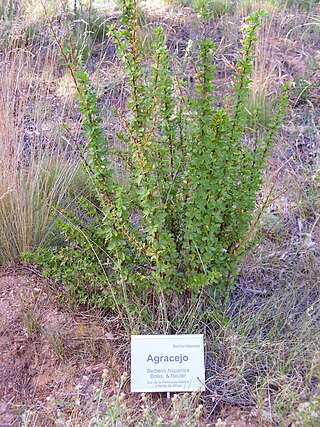
Berberis vulgaris subsp. australis, synonym Berberis hispanica, is a shrub belonging to the family Berberidaceae and the genus Berberis. It is a woody plant and parts of the plant are considered toxic, although the berries are edible and juicy.

Berberis koreana, the Korean barberry, is deciduous shrub that can grow up to 5 feet (1.5 m) in height. The species is endemic to Korea. It is widely planted as an ornamental tree in North America, South America and Europe.

Berberis haematocarpa, Woot. with the common names red barberry, red Mexican barbery, Colorado barberry and Mexican barberry, is a species in the Barberry family in southwestern North America. It is also sometimes called algerita, but that name is more often applied to its relative, Mahonia trifoliolata.

Berberis bealei, also known as leatherleaf mahonia, Beale's barberry, is a species of evergreen shrub native to mainland China. The species has been regarded as the same species as Berberis japonica, native to Taiwan, but the two differ consistently in certain floral and leaf characters. Both species are widely cultivated in many countries as ornamentals. Berberis bealei has reportedly escaped cultivation and become established in the wild in scattered places in the south-eastern United States from Arkansas to Florida to Delaware.
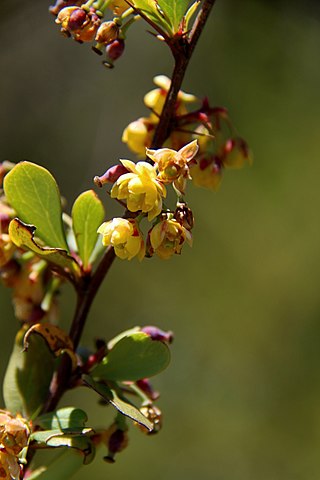
Berberis holstii is a spiny evergreen shrub assigned to the barberry family, with simple leaves, hanging panicles with a few yellow flowers and eventually blackish-blue berries. It is one out of only species of Berberis that grow in the wild in Africa, where it can be found at high altitudes in Tanzania, Uganda, Kenya, Ethiopia, Somalia, and Malawi. It is also reported from Yemen and Oman. In Malawi it is known as Kayunga, while in Ethiopia it is called Gewo, Yeset af in Amharic, as well as Zinkila, a name also used in the Afar language, and Godxantool in the Somali language.

Berberis empetrifolia, sometimes called heath barberry, is a low, somewhat spiny shrub belonging to the barberries in the family Berberidaceae. The local names in Chile are zarcilla, monte negro and uva de la cordillera. It has small narrow entire leaves, and small yolk-colored flowers and later globose blue-black berries. The species is native to south of 30ºS in Argentina and Chile, where it grows on sunny, often gravelly soils, and is sometimes planted as an ornamental elsewhere in temperate climates.

Berberis ilicifolia, sometimes called holly barberry or holly-leaved barberry is a medium to high, spiny shrub belonging to the barberries in the family Berberidaceae. The local name in Chile is Chelia. It has ovate leaves with a few teeth that end in spines, reminiscent of holly leaves. Its orange flowers grow with three to seven together, which later produce globose blue-black berries. The species is native to south of 40ºS in Argentina and Chile, where it grows in Nothofagus woods. Flowers are present from August to December, while ripe berries are available between November and March.






















